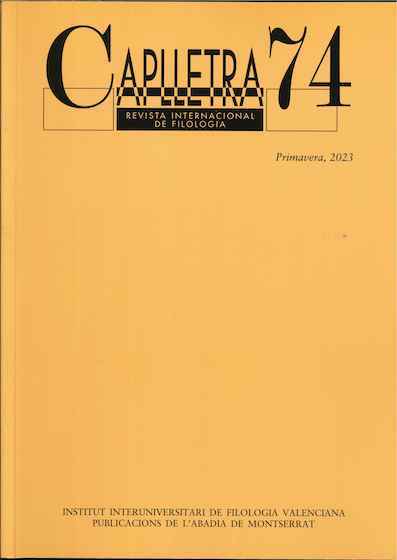Differential object marking in Catalan: where do we come from and where do we go to?
DOI:
https://doi.org/10.7203/caplletra.74.26040Keywords:
differential object marking, Catalan, diachronic variation, dialectal variation Abstract
Abstract
In this paper we analyse Differential Object Marking (DOM) in Catalan both from the point of view of its diachronic evolution and from the perspective of its current scope across Catalan dialects nowadays. First, our large-scale corpus study of Old Catalan shows that the phenomenon already existed in previous stages of the language (with personal pronouns, personal names, and NPs), so that, in this sense, it can be considered a genuine phenomenon. However, diachronic data also indicate very clearly that from the 16th century onwards, when the influence of Spanish became an increasingly severe reality, the percentage of use of the preposition a in front of DOs increased exponentially.
Although at the beginning of the 20th century the publication of the first Catalan prescriptive grammar meant a before and after in the appearance of the phenomenon in formal written texts, the fact is that the Catalan-speaking community has never get rid of this morphosyntactic resource, quite the opposite. This is amply confirmed by a large-scale study on the scope of the phenomenon in all Catalan dialects, based on individual interviews with around 400 speakers, who were asked to carry out both a sentence production task and a grammaticality judgment task.
 Downloads
Downloads
Downloads
Published
How to Cite
-
Abstract334
-
PDF (Català)492
Issue
Section
License
Authors submitting work to Caplletra for publication must be the legitimate holder of the usage rights. Legitimacy for the purposes of publishing the work must also include images, tables, diagrams and any other materials that may complement the text, whether they are the author of such material or not.
Copyright: on publishing their work in the journal, the author grants Caplletra. Revista Internacional de Filologia usage rights (reproduction, distribution and public communication) for both the paper printed version and for the electronic version.
All work published in Caplletra is covered by the Creative Commons license type Attribution-NonCommercial-NoDerivatives 4.0 (CC BY-NC-ND 4.0).
RESPONSABILITY
Caplletra. Revista Internacional de Filologia does not necessarily identify with the points of view expressed in the papers it publishes.
Caplletra. Revista Internacional de Filologia accepts no responsibility whatsoever for any eventual infringement of intellectual property rights on the part of authors.






